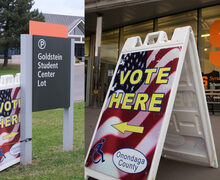Luxury student apartments can hurt Syracuse community
Corey Henry | Photo Editor
Even though Syracuse University is now learning from home, students are still putting together their housing plans for the coming academic year. Over the past few years, a variety of luxury student housing complexes have sprouted up near campus, offering students a more comfortable alternative to the larger, older houses that dominate the student housing market. These student apartment complexes divert important resources and attention from the surrounding neighborhood that needs help.
Developments such as Theory Syracuse, The Marshall and The 505 on Walnut offer a plush living experience to college students, with gyms, private shuttles, shopping centers and various other amenities. Housing developments like these have become omnipresent in the neighborhood surrounding SU, specifically targeting students and catering toward their preferences. The city has financially backed these developments as well, providing tax incentives and subsidies to developers. Just blocks away from these luxury apartments are public housing complexes, many of them run down and substandard.
“We have a crisis in this city. A crisis of affordable housing. A crisis of substandard housing. So, there’s dire urgency to address issues of housing in the community, and this is where the attention is going,” said Gretchen Purser, an associate professor of sociology at SU. “And the problem is when these developments get these tax breaks. There’s no problem in itself with development, but that a lot of these have been tax subsidized.”
The city of Syracuse struggles with a variety of housing-related problems, including a lack of accessible and livable housing for families. Many homes in Syracuse and Onondaga County have lead paint in them, making residing there dangerous. These two realities exist less than a mile apart, begging the question of why resources are being allocated toward more and more luxury apartment buildings for students when permanent Syracuse residents struggle to access appropriate housing themselves.
It’s true that the mere presence of student-targeted luxury housing doesn’t harm the community and could serve as a viable option for many students, but the repercussions on the greater community can’t be overlooked.
“The big concern that people are expressing is what impact will it have on housing near the university, and will students be fleeing all of these houses that have been converted to student rentals,” Purser said.
Additionally, every tax dollar allocated to these projects is one that may have been better spent addressing housing concerns with a greater impact on the entire Syracuse community. SU can often feel like a bubble disconnected from the realities of its city.
Purser said these luxury apartments, designed to replicate the attitudes and lifestyles of the metropolitan cities so many students are originally from, serve as yet another distinction between the SU experience and that of local Syracuse residents.
“I think one particularly concerning aspect of these developments is that they all have their private shuttles…they’re using public space but they’re these private companies ushering around this incredibly privileged group of students, who therefore have even less engagement with the actual society and the actual Syracuse residents,” she said. “So, for me, that’s one of the most problematic elements.”
While the city of Syracuse and New York state have played the most significant role in proliferating these developments through financial incentives, they only did so in response to student demand. There is absolutely a role that students can play in minimizing the adverse impacts of these apartments.
Students should try to genuinely engage with and participate in the greater Syracuse. While amenities like private shuttles are certainly convenient, they also reinforce distinctions between those with the privilege to live in these apartments and those without it. This rift exists between Syracuse students and the greater community within the city, but it also has a presence within our campus, designating haves and have-nots among the student body.
It is the obligation of SU students to serve the community they call home for four years to the best of their ability and leave it better than they found it. It is their obligation to create a space on campus that is as inclusive of all people as possible, regardless of any circumstances including financial. Luxury student housing can have a place on this campus if it can exist in a way that does not reinforce class divisions in the campus community as well as the city, but that will take effort and work on the part of the students residing there.
Published on March 25, 2020 at 5:34 pm





